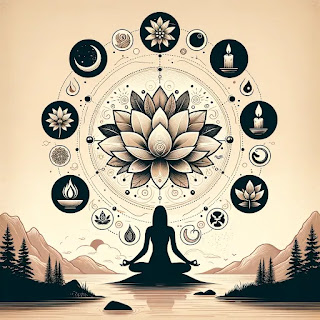Exploring the Eight Limbs of Yoga: A Guide to Holistic Practice
The Eight Limbs of Yoga: Everything You Need to Know to Revolutionize Your Practice
What are the Eight Limbs of Yoga?

What is Yoga and why do we practice?
Yoga is so much more than a physical activity involving poses and postures. For many, including myself, yoga has become a lifestyle encompassing physical, mental, and spiritual discipline that originated in ancient India. Its goal is to harmonize the body and mind, ultimately leading to self-realization and liberation (moksha). Yoga comprises various methods and techniques, including postures (asanas), breathing exercises (pranayama), meditation (dhyana), and social norms (yamas and niyamas). The word “yoga” is derived from the Sanskrit word “yuj,” which means to join or to attach.
There is no single way to practice yoga. Today, I plan to explore some of the less popular but equally important aspects of yoga. As Ralph Waldo Emerson beautifully put it, “What lies behind us and what lies before us are tiny matters compared to what lies within us.” This quote captures the essence of yoga, reminding us that the true journey is inward, toward discovering our inner strength and peace.
The Eight Limbs of Yoga
The sage Patanjali systematized the approach to yoga in his Yoga Sutras, categorizing it into the Eight Limbs of Yoga. These limbs provide a practical framework to explore the purpose of yoga, helping us live a meaningful, balanced, and spiritual life.
What are the Eight Limbs of Yoga?
The five yamas – social and personal disciplines
The yamas represent the first limb of the Eight Limbs of Yoga and are considered to be the attitudes and behaviors that foster and support a peaceful, harmonious, and ethical life, both in society and in the personal practice of yoga. Without the yamas, the higher states of human consciousness cannot be attained.
Ahimsa (nonviolence)
- Principle: kindness and nonviolence toward all living creatures.
- Practice: the cultivation of empathy and compassion. We avoid causing harm with our thoughts, words, and actions, and seek to embed peace and understanding in all our interactions.
Satya (honesty)
- Principle: speak the truth and support others who do.
- Practice: honesty in communication, thought, and action. For yoga practitioners this means aligning our words and actions and being present and authentic in all our interactions, so that trust and openness can flourish.
Asteya (non-stealing)
- Principle: refraining from taking things that are not yours.
- Practice: respecting the property and time of others and developing gratitude for what we have. This quality extends beyond mere material possessions to include intellectual and emotional respect.
Brahmacharya (celibacy or moderation)
- Principle: fidelity, constancy, and straightforward honest relationships.
- Practice: this precept is commonly understood as moderation and control in the use of all your energy, especially sexual. It includes maintaining healthy and respectful relationships and channeling your energy in positive ways.
Aparigraha (non-coveting)
- Principle: refraining from desiring what is not yours.
- Practice: overcoming greed and excessive possessiveness towards material things. It advises us to detach from excessive attachment to possessions and encourages simplicity and satisfaction, so that we may cultivate an attitude of abundance and generosity.
Conclusion
The five yamas offer us guidelines for ethical conduct and spiritual development. By adhering to these principles, we can create peaceful and harmonious relationships, build a peaceful community and foster inner peace. The yamas assist the yoga practitioner to explore and understand their interaction with other beings and their inner moral guide, and offer practical solutions for living a balanced and meaningful life.
The five niyamas – observances for a wholesome life
- Saucha (purity)
Saucha or purity involves the cleansing and purification of the body and mind. On a physical level, it includes the cleanliness of your surrounding and of your body. Mental purification occurs when we eliminate the distractions and impurities of our mind and direct our focus towards an object of contemplation. Through purification, we can observe and tolerate the presence of other beings and explore our inner energies and peace. Dedicating time and energy to this practice develops mental agility and emotional stability, allowing for a deeper experience of the true and innermost self within.
- Santosa (contentment)
Santosa involves the cultivation of contentment and serenity in life and with what life offers us. This precept emphasizes the importance of gratitude and acceptance of the present moment and of our life circumstances. Contentment arises when we learn to be happy with what we are, where we are, and with what we have. The practice of santosa helps us to adopt a positive attitude towards life and diminishes unnecessary desires and dissatisfaction with our current state of affairs.
- Tapas (burning anguish)
Tapas means purification of body and mind through austerity, will power and self-discipline. Considered as the inner fiery transformation that governs all processes of growth and change in an individual, tapas is often seen as the fourth and necessary step in the path of spiritual evolution.
The practice of tapas or spiritual discipline is accomplished through dedicated actions performed regularly with intensity and control. Activities such as meditation, physical postures, breathing exercises, self-reflection and eating consciously, to name a few, contribute to spiritual development and help maintain the strength and stability needed for the deep exploration of our innermost self.
- Svadhyaya (study)
Svadhyaya means study and self-study. This precept involves the study of sacred texts and scriptures, self-reflection and observation of our thoughts and actions, and investigation of the true meaning of life. Through self-knowledge, we can make wiser choices and align our thoughts and actions to our values and intentions. The practice of this observance enables us to be perpetual students and offers us the opportunity to expand and deepen our level of consciousness at any stage of our evolution.
- Ishvara pranidhana (surrender to god/master)
Ishvara pranidhana, the fifth niyama, means surrendering your actions to God/master. It refers to the recognition that yoga is a spiritual endeavor and that there is a higher, intelligent force at work than our own limited will. To progress on the yogic path, we must surrender completely to this divine will and intelligent energy. Through this observance, we develop humility, trust and purpose in our lives and transcend our limited identities and egos. We learn to function from a larger context of consciousness and harmonize with the all-encompassing spirit.
By embracing the five niyamas in our everyday lives, we can build a wholesome and balanced physical, mental and spiritual existence.
Dharana, dhyana and samadhi
Dharana, the sixth limb of yoga, means one-pointedness or concentration. In this practice, you focus your entire attention on a chosen object of concentration and maintain your focus without any distraction or wavering of the mind. By holding your consciousness steadily on an object (e.g., breath, mantra, visual designation, chakra or internal sound), you gradually develop an unwavering and one-pointed mind. Dharana is the natural precursor for the next limb of yoga, meditation (dhyana), and other similar techniques of deep concentration and sustained attention like those found in Zen Buddhism.
The practice of Dharana reduces mental chatter and enhances cognitive abilities. It improves our concentration and focus in whatever action we engage in, including our yoga asana and daily activities. With persistent practice of one-pointedness, we learn to keep our mind and attention internalized and focused, rather than wandering in the external world of designations.
Dhyana, the seventh limb of yoga, is meditation. Unlike Dharana where the concentration is still actively held in place through effort and control of the mind, Dhyana involves achieving a state of meditative absorption through continuous and unbroken focus on the chosen object of meditation. In Dhyana, the meditative experience becomes so deep that the meditator, the meditation and the object of meditation appear as a unified whole. The meditative state (Dhyana) and the meditative experience (Samadhi) become one. In this profound state of absorption, the mind is no longer active in a thinking or reasoning way but becomes deeply engaged and immersed in the object of meditation with a sense of flow and inner tranquility. Dhyana helps us to develop inner stillness, quietness and awareness in our daily lives and leads us to a deeper understanding of our true self and the essence of the present moment. The experience of Dhyana transforms us and helps us to realize our true nature.
Samadhi, the eighth and highest limb of yoga, is pure contemplation. It is the culmination and fulfillment of the meditation process. In Samadhi, you become completely identified with the object of meditation and merge in the eternal essence of oneness. In this state, there is no duality and the meditator, meditation and the object of meditation appear as seamless whole. The individual egoic self has dissolved and all distinctions have vanished. In this depth of inner tranquility, serenity and bliss, you experience the infinite, all-comprehensive consciousness and eternal happiness. Samadhi is often described as the state of enlightenment, realization of Brahman, liberation from the cycle of karma and rebirth and union with the divine essence of existence.
Yoga practices such as Pranayama and Dharana help us develop the stability, strength and flexibility needed to maintain the meditative state of mind and engage in deep meditation. With persistent and regular practice of Dhyana and Samadhi, we can experience deeper states of relaxation, concentration and mental poise in our day-to-day activities.

Yoga Sutras Inspiration and Guidance for everyday life
The Yoga Sutras are the ancient wisdom teachings of the sage Patanjali. This highly revered text of probably the most popular physical, mental and spiritual discipline of our times offers a practical blueprint for living a balanced, harmonious, ethical and purposeful life. The Yoga Sutras consist of 196 sutras (or aphorisms) and are categorized into four different chapters:
- Samadhi Pada: Deals with the purpose and aim of yoga and the nature of Samadhi (deep meditative absorption).
- Sadhana Pada: Describes the necessary attitudes and practices leading to spiritual development including the eight limbs of yoga (Ashtanga Yoga).
- Vibhuti Pada: Explains the siddhas (supernatural powers) that may manifest through the practice of higher stages of yoga.
- Kaivalya Pada: The last chapter speaks of the nature of release and the ultimate goal of yoga which is liberation from suffering (dukkha) and union with the divine (Siva, the supreme consciousness).
Yoga practices such as Yoga Sutras offer guiding principles and practices that transcend cultural and temporal barriers and provide practical solutions for the ups and downs of life. Some of the key teachings of the Yoga Sutras include:
- The two 2 sets of ethical rules (Yamas and Niyamas) that guide moral behavior and personal discipline.
- Asana and Pranayama, the physical postures and breathing exercises that purify your body and energetic system.
- Pratyahara, Dharana, Dhyana and Samadhi, the mental disciplines that help you master your mind and attain higher states of spiritual awareness.
Through the application of these eight limbs, you can achieve liberation from the limitation of the mind and body and realize the state of liberation and inner freedom. The Yoga Sutras thus become a precious and timeless guide for all those who aspire to live a balanced, harmonious, ethical and spiritually inspiring life.

Revolutionizing Your Yoga Practice
How can the eight limbs help me in my spiritual journey?
Develop Self-Awareness
The eight limbs of yoga philosophy begin with the Yamas and Niyamas, the two sets of ethical rules and personal observances that help you cultivate self-awareness and self-discipline. The Yamas and Niyamas help you develop strong moral guidelines and virtues such as non-violence, truthfulness, continence, compassion, honesty, contentment and self-control. Through the careful observation of these ethical precepts, you learn to be aware of your thoughts, actions and their consequence on yourself and others. This creates the necessary foundation for entering into deeper spiritual practices.
Physical and Mental Discipline
Asana (physical postures) and Pranayama (breathing exercises) are the third and fourth limbs, focusing on the physical and energetic aspects of your being. Regular practice of Asanas helps to purify and strengthen the body, making it a stable and resilient vessel for spiritual practices. Pranayama, on the other hand, regulates the flow of life force energy (Prana), enhancing your vitality and calming the mind. Together, these practices foster physical health and mental clarity, essential for deeper meditative states.
Concentration and Meditation
Pratyahara (withdrawal of the senses from external world), Dharana (concentration), and Dhyana (meditation) are the next steps, guiding you inward. Pratyahara involves withdrawing your senses from external distractions, helping you to focus your awareness inward. Dharana cultivates intense concentration on a single point of focus, whether it be your breath, a mantra, or a visual object. As concentration deepens, it naturally transitions into Dhyana, a state of uninterrupted meditation. These practices train the mind to remain steady and undistracted, allowing you to access deeper layers of consciousness.
Attaining the Highest State of Awareness
The culmination of the eight limbs is Samadhi, the eighth limb, which represents the highest state of awareness and spiritual enlightenment. In Samadhi, the boundaries between the meditator, the act of meditation, and the object of meditation dissolve, leading to a profound experience of oneness with all that exists. This state of pure consciousness is characterized by a sense of unity, bliss, and ultimate freedom from suffering.
Practical Steps for Holistic Personal Development
The eight limbs of yoga offer a comprehensive and practical framework for holistic personal development. By integrating these practices into your daily life, you can:
- Develop greater self-awareness and ethical integrity.
- Achieve physical and mental balance and well-being.
- Enhance concentration and mental discipline.
- Experience deeper states of meditation and inner peace.
- Ultimately, attain spiritual enlightenment and a sense of oneness with the universe.
Experiencing a More Meaningful and Purposeful Life
Practicing the eight limbs of yoga can lead to a more meaningful and purposeful life. By aligning your actions with higher ethical standards and cultivating a deeper connection with your true self, you can experience greater fulfillment and contentment. The journey through the eight limbs transforms not only your physical body and mental state but also your spiritual consciousness, guiding you towards a state of Samadhi, where you experience the ultimate reality and unity with all existence.
In essence, the eight limbs of yoga provide a structured path for spiritual growth, helping you navigate the complexities of life with greater awareness, discipline, and inner peace, ultimately leading to the highest state of spiritual awakening.





